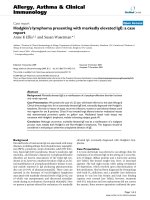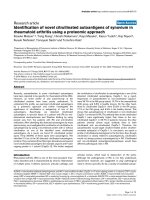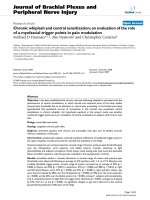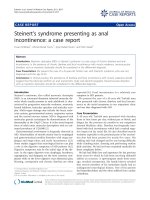Báo cáo y học: " Wegener''''s Granulomatosis presenting with an abscess in the parotid gland: a case report" pdf
Bạn đang xem bản rút gọn của tài liệu. Xem và tải ngay bản đầy đủ của tài liệu tại đây (1.28 MB, 4 trang )
BioMed Central
Page 1 of 4
(page number not for citation purposes)
Journal of Medical Case Reports
Open Access
Case report
Wegener's Granulomatosis presenting with an abscess in the
parotid gland: a case report
Marcel Geyer*, Gautham Kulamarva and Anne Davis
Address: Department of Otorhinolaryngology, Head and Neck Surgery, Queen Alexandra Hospital, Southwick Hill Road, Cosham, Portsmouth,
Hampshire, UK
Email: Marcel Geyer* - ; Gautham Kulamarva - ;
Anne Davis -
* Corresponding author
Abstract
Introduction: Wegener's Granulomatosis is a vasculitis of uncertain aetiology. Affected patients
usually present with disease of the respiratory and renal tracts. Classic symptoms and clinical
findings, together with serology titres positive for anti-neutrophil cytolplasmic antibody against
proteinase 3 confirm the diagnosis. Wegener's Granulomatosis can occasionally involve other
organs, but solitary parotid gland disease is uncommon; patients generally also have systemic
disease.
Case Presentation: We report a case of Wegener's Granulomatosis in a 69-year-old Caucasian
female presenting initially with an isolated parotid abscess and only subsequently developing nasal,
paranasal sinus and respiratory symptoms. We describe the clinical course, diagnostic difficulties,
imaging and histopathology of this case.
Conclusion: Major salivary gland infection is not an uncommon ENT disorder, but the clinician
should be wary of the patient who fails to respond appropriately to adequate therapy. In such cases
a differential diagnosis of Wegener's Granulomatosis should be considered, as early recognition and
treatment of this potentially fatal disease is paramount.
Introduction
Heinz Klinger was first to describe the disease process of
Wegener's Granulomatosis (WG) in 1932.[1]. Subse-
quently, Frederick Wegener published his two papers in
1936 [2] and 1939 [3] describing post-mortem studies of
two patients who died of disseminated vasculitis. WG
usually presents as a triad of airway necrotising granulo-
mas, systemic vasculitis and focal necrotising glomeru-
lonephritis. The diagnosis of WG is based on clinical
findings and positive anti-neutrophil cytolplasmic anti-
body against proteinase 3 (cANCA-PR3) serology. A
biopsy is rarely histologically diagnostic [4]. Our case is
unusual in that the patient presented initially solely with
a parotid abscess in the absence of typical signs or symp-
toms of rhinologic or systemic WG.
Case Presentation
A 69-year-old Caucasian female presented with a 10-day
history of worsening pain and swelling over the region of
the left parotid gland. She had been unsuccessfully treated
with a 7-day course of oral penicillin by her general prac-
titioner, but with no improvement. She denied any pre-
cipitating cause, though she had been feeling 'under the
weather' and had lost her appetite over some weeks; there
Published: 23 January 2009
Journal of Medical Case Reports 2009, 3:19 doi:10.1186/1752-1947-3-19
Received: 16 March 2008
Accepted: 23 January 2009
This article is available from: />© 2009 Geyer et al; licensee BioMed Central Ltd.
This is an Open Access article distributed under the terms of the Creative Commons Attribution License ( />),
which permits unrestricted use, distribution, and reproduction in any medium, provided the original work is properly cited.
Journal of Medical Case Reports 2009, 3:19 />Page 2 of 4
(page number not for citation purposes)
was no history of parotid disease. There was no other sig-
nificant medical history and she was a non-smoker.
Clinically she was pyrexial (37.7°C), dehydrated and in
discomfort due to left facial swelling with a marked degree
of trismus. An 8 cm by 5 cm tense, tender, fluctuant swell-
ing was palpable in the left parotid gland, and the lower
pole of the pinna was displaced laterally. Examination of
neck, ears and nose (by flexible nasendoscopy) was nor-
mal. Intra-oral inspection confirmed that there was no
discharge from Stenson's duct and no calculus was palpa-
ble. She did however demonstrate a House-Brackmann
Grade II palsy of the left marginal mandibular nerve; all
other cranial nerves were intact. A full blood count
showed a neutrophilia of 15.0 × 10
9
/l (WCC = 17.9 × 10
9
/
l); plasma C-reactive protein (CRP) was markedly raised
(285 mg/l). An initial chest X-ray was normal.
Large-bore needle aspiration of 15 ml of frank pus from
the left parotid gland provided some relief and lessened
the trismus. Intravenous antibiotic treatment with Metro-
nidazole and Amoxicillin/Clavulanate and rehydration
were commenced. An ultrasound scan the following day
could not identify a collection in the left parotid. How-
ever, as the patient remained unwell, formal incision and
drainage was performed after 3 days. A further 10 ml of
pus was drained and a biopsy taken which showed non-
specific inflammation. Despite this treatment, within a
week her condition deteriorated, complicated by respira-
tory symptoms (chest pain, dyspnoea and a non-produc-
tive cough). A repeat chest X-ray showed fixed infiltrates
and cavitation of both lung fields (Figure 1). Transfer of
care to the respiratory team and empirical treatment for
suspected Staphylococcus Aureus cavitating pneumonia
led to improvement and discharge home 17 days after
admission.
Unfortunately she was re-admitted after a further 5 days
with progressive respiratory failure requiring transfer to
the Intensive Care Unit (ICU) and ventilatory support.
Ear, nose and throat (ENT) examination in ICU revealed
bilateral otitis externa, destruction of the nasal septum
and granulomatous appearance of the mucosa. An urgent
CT scan showed extensive septal and lateral nasal wall
destruction without intracranial complications.
The combined evidence of a history of feeling unwell with
loss of appetite, clinical findings of septal perforation and
friable nasal mucosa as well as the radiological features of
pulmonary infiltrates and cavitation suggested WG. A
serum cANCA titre was strongly positive (Ratio 2.5 of Pro-
teinase 3), confirming the diagnosis. Treatment with
Methylprednisolone, Prednisolone and Cyclophospha-
mide was given and adjunctive supportive measures con-
tinued, leading to clinical improvement and gradual
disease resolution. The patient was ultimately discharged
3 months after the original admission. Serial CRP meas-
urements correlated well with the disease severity (Figure
2). Histological examination of a nasal biopsy taken in
ICU confirmed features of WG retrospectively: necrotising
granulomata, foci of necrosis and blood vessels showing
fibrinoid necrosis and inflammation of their walls. Nei-
ther acid-fast bacilli nor evidence of malignancy were
found.
Discussion
The often rapidly progressive and potentially fatal disease
Wegener's Granulomatosis affects mainly the upper and
lower respiratory tracts and the kidneys. Early recognition
and treatment is paramount in preventing severe organ
damage. The peak age incidence is at 50 to 60 years and
confined almost entirely to Caucasoid individuals [5,6].
The exact aetiology remains unclear. It may represent
some form of hypersensitivity reaction and immune
response to an unknown stimulus. Two types of WG are
described: the most common is a multi-system disease;
the other is confined to one area of the respiratory tract.
Non-specific systemic symptoms of WG include fatigue,
fever, arthralgia and weight loss. Head and neck symp-
toms occur in 90% of patients: the nose, paranasal sinuses
(up to 80%) [6] and middle ear [7] are commonly
affected. Nasal symptoms of the disease include serosan-
guinous discharge and headache and pain over the dor-
sum. Signs comprise crusts covering friable mucosa,
ulceration, septal perforation and saddle-nose deformity.
Oropharyngeal, laryngeal and facial nerve involvement,
X-ray Chest – Cavitating pneumoniaFigure 1
X-ray Chest – Cavitating pneumonia.
Journal of Medical Case Reports 2009, 3:19 />Page 3 of 4
(page number not for citation purposes)
among others, has been described. Involvement of sali-
vary glands occurs in less than 1% [8].
The largest series described five cases of WG involving the
salivary glands [9]. Disease of a major salivary gland
almost always coincides with other head and neck or pul-
monary signs and symptoms [10]. Thus major salivary
gland involvement is a rare presentation of WG, and all
patients described have had concomitant nasal, ear or
lung symptoms and signs [10-15]. One patient went on to
develop a parotid abscess following admission [12]. None
have presented ab initio with an abscess but without other
symptoms, as we describe here.
The diagnosis is based on clinical criteria including oral
ulcers and nasal serosanguinous discharge, abnormal uri-
nalysis and chest X-ray, supported by the histological find-
ings of an adequate biopsy showing granulomatous
inflammation and positive laboratory studies (cANCA-
PR3 titres). Therapeutic response to immunosuppressive
agents (cyclophosphamide or azothioprine) combined
with steroids is good, with remission rates of up to 90%.
If treatment is initiated early, involvement of the lower
respiratory tract and kidneys may be avoided. Sinonasal
manifestations may be treated medically with saline
douching and topical nasal or systemic steroids. For bac-
terial superinfection antibiotics are prescribed. Long term
follow up is essential to detect possible relapse, suggested
by rising ANCA levels.
Conclusion
Major salivary gland infection is not an uncommon ENT
disorder, but the clinician should be wary of the patient
who fails to respond appropriately to adequate therapy. In
such cases a differential diagnosis of WG should be con-
sidered, as early, appropriate treatment is paramount in
preventing significant morbidity or mortality.
Abbreviations
CRP: C reactive protein; cANCA PR3: anti-neutrophil
cytoplasmic antibody against proteinase 3; WCC: white
cell count; ENT: ear, nose and throat
Competing interests
The authors declare that they have no competing interests.
Patient serial serum CRP measurementFigure 2
Patient serial serum CRP measurement.
Publish with BioMed Central and every
scientist can read your work free of charge
"BioMed Central will be the most significant development for
disseminating the results of biomedical research in our lifetime."
Sir Paul Nurse, Cancer Research UK
Your research papers will be:
available free of charge to the entire biomedical community
peer reviewed and published immediately upon acceptance
cited in PubMed and archived on PubMed Central
yours — you keep the copyright
Submit your manuscript here:
/>BioMedcentral
Journal of Medical Case Reports 2009, 3:19 />Page 4 of 4
(page number not for citation purposes)
Authors' contributions
MG was a major contributor in writing the manuscript.
GK reviewed the patient's notes, collected the haemato-
logical and histological data and radiology slides and
AD was a major contributor in writing the manuscript. All
authors read and approved the final manuscript.
Consent
Written informed consent was obtained from the patient
for publication of this case report and accompanying
images. A copy of the written consent is available for
review by the Editor-in-Chief of this journal.
Acknowledgements
Histopathology staff at the laboratory of the Queen Alexandra Hospital, for
their preparation of the histology slides.
References
1. Klinger H: Grenzformen der Periarteritis Nodosa. Fr Z Pathol
1931, 42:455-480.
2. Wegener F: Über generalisierte, septische Gefäßerkrankun-
gen. Verh Dtsch Ges Pathol 1936, 29:202-210.
3. Wegener F: Über eine eigenartige rhinogene Granulomatose
mit besonderer Beteiligung des Arteriensysytems und der
Nieren. Beitr Path Anat 1939, 102:36-38.
4. Langford CA, Fauci AS: The vasculitis Syndromes. Harrison's Principles of
Internal Medicine 15th edition. Edited by: Fauci AS, Braunwald E,
Kasper DL, Hauser SL, Longo DL, Jameson JL, Loscalzo J. New York:
The McGraw-Hill companies Inc; 2001:1937-1939.
5. Saravanappa N, Bibas A, Singhal A, Davis JP: Unilateral parotid
swelling as initial manifestation of Wegener's granulomato-
sis. J Otolaryngol 2006:396-397.
6. Murty GE: Wegener's granulomatosis: Otorhinological mani-
festations. Clin Otorlaryngol 1990, 15:385-393.
7. Kempf HG: Ear involvement in Wegener's granulomatosis.
Clin Otolaryngol 1989, 5:451-456.
8. Lloyd G, Lund VJ, Beale T, Howard D: Rhinologic Changes in
Wegener's Granulomatosis. J Laryngol Otol 2002, 116:565-569.
9. Specks U, Colby TV, Olsen KD, DeRemee RA: Salivary gland
involvement in Wegener's Granulomatosis. Arch Otolaryngol
Head Neck Surg 1991, 2:218-223.
10. Chegar BE, Kelly RT: Wegener's Granulomatosis presenting as
unilateral parotid swelling. Laryngoscope 2004, 114:1730-1733.
11. Bülbül Y, Ozlü T, Oztuna F: Wegener's granulomatosis with
parotid gland involvement and pneumothorax. Med Princ Pract
2003, 12:133-137.
12. Imamoglu M, Bahadir O, Reis A: Parotid gland involvement as an
initial presentation of Wegener's granulomatosis. Otolaryngol
Head Neck Surg 2003, 4:
451-453.
13. Murty GE, Mains BT, Bennett MK: Salivary gland involvement in
Wegener's granulomatosis. J Laryngol Otol 1990, 3:259-261.
14. Benson-Mitchell R, Tolley N, Croft CB, Roberts D: Wegener's
granuloma – presenting as a unilateral parotid swelling. J
Laryngol Otol 1994, 108:431-432.
15. Liu SY, Vlantis AC, Lee WC: Bilateral parotid and Submandibu-
lar Enlargement: A rare feature of Wegener's Granulomato-
sis. J Laryngol Otol 2003, 117:148-150.









